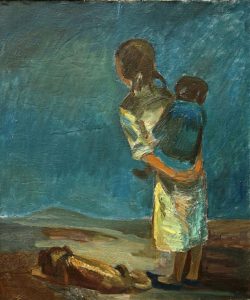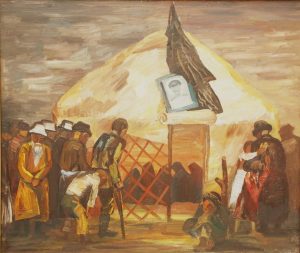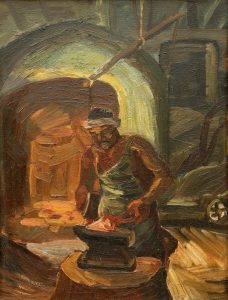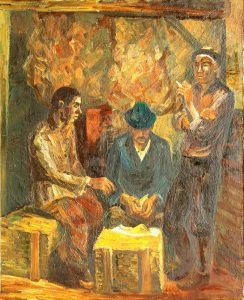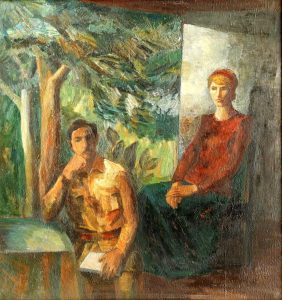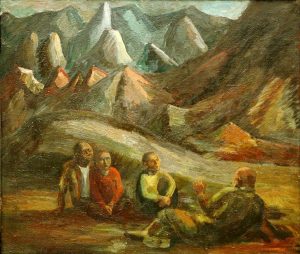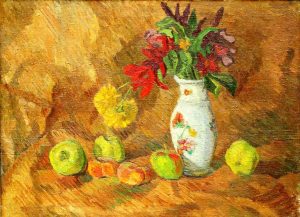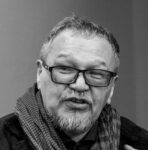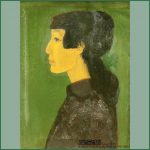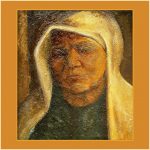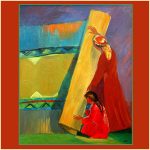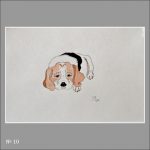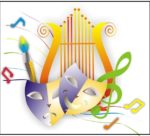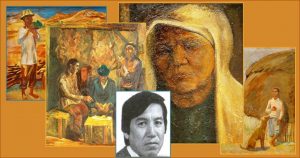 We continue to introduce the works of Kyrgyz artists presented in the collection of the National Museum through the eyes of art critic GAMAL BOKONBAYEV. This is the second section of two dedicated to the work of Aman Asrankulov.
We continue to introduce the works of Kyrgyz artists presented in the collection of the National Museum through the eyes of art critic GAMAL BOKONBAYEV. This is the second section of two dedicated to the work of Aman Asrankulov.
Asrankulov Aman (1939-1998) – painter. He was born in Frunze. In 1964 he graduated from the Frunze Art College and in 1969 – the Faculty of Painting of the Moscow Art Institute named after V.I. Surikov. People’s Artist of the Kyrgyz Republic. Since 1971 – member of the Union of Artists of the USSR.
My parents. Oil on canvas, 113.5×97.5, 1985
Parents are standing nearby, preparing to meet the festive date. A pentagonal mirror, elongated, hangs on the wall behind. It is enough to take a closer look and it turns out that the old people are not standing next to each other. Mirror reflects the veteran. Only the spouse is in front of the mirror, this is emphasized by the falling shadow. In a white scarf, in a dark suit, he carefully holds the order in his hands. She has a happy… and mournful face. She is going to wear the order… However, there is no one. She looks somewhere into the distance, into a parallel mirror world. There is a front-line soldier; he is wearing a gray suit with awards, a gray shirt, and a burgundy tie. The gray hair has risen from the breeze and is intertwined with the clouds…. We do not know the biography of the artist’s parents (this, by the way, is a task for museum researchers). From very scant information, it is known that the artist’s father, BORUBAI ASRANKULOV, a veteran of the Great Patriotic War, was born in 1912 in the Osh region. In 1985, the Minister of Defense of the USSR awarded him the jubilee award, the Order of the Patriotic War I degree. An old mother holds it in the picture. Apparently, the veteran did not wait for this high award … In the same year the picture was painted. The color is not cheerful. Gray-ochre, dark brown colors with small-accentuated colored inserts. Unusual composition: all elements are shifted to the left. On the left side of the table is a jug with flowers, most likely purple crocuses, and a case for the order. Two yellow flowers symbolically drooped. An empty field remains on the right. Thus, the order in the hands of the mother is moved to the center and the plot value of the award is indicated. On the other hand, perhaps the artist wanted to finish the right part of the picture … and did not.
Summer. Oil on canvas, 61×65, 1983
Somewhere on the outskirts of the field, near a clay tandoor, a young man and a girl are eating fried corn. The coals are still smoldering in the stove, there is a black cumgan* nearby, there is firewood left. A young man in a kalpak** and barefoot, a girl in a red dress. Clear, sunny, judging by the shadows – noon. Most likely, it’s August, but it is not hot for young people. Light ochre dominates, together with red ochre; they create a “fried” flavor. There are transparent shadows on the light undercoat. A shirt of a warm shade is written in white; cold smoke from the fire is indicated. Narrow strip of blue sky and green trees under the hills complement the fiery palette. It seems that not only the corn is fried. The summer, the earth, the air are fried! A young man and a girl were fried. They are not hot, they are lovers! Soviet artists were able to see a kind of poetry in the simple artless peasant life; they were able to appreciate the unpretentious romance of steppe freedom…. The theme of two is this favorite theme of Kyrgyz painters, let us remember: Gapar Aitiev “On the outskirts of the village” (1959), Alexander Voronin “Uch-Kurgan” (1968). There are two of them here, too. They are, of course, collective farmers (there were no others in those days), but it is great to escape from everyone and be alone together. Steal collective farm corn, roast it and eat it.
*Kumgan – a narrow-necked vessel, a jug for water. Used for washing and ablution
**Kalpak – traditional Kyrgyz men’s felt headdress
Expectation. Oil on canvas, 81,5×69, 1982
A little girl is holding a very little brother on her back. She stands with her back to us and gazes intently into the wide steppe. The girl is dressed simply: a white dress and a gray tank top. On her feet are black Asian galoshes. The little one is dressed in dark blue, the same shades as the evening sky. A dog is lying nearby, judging by the pose, it has been lying for a long time. They are waiting for the return of adults from collective farm fields. This is understandable: summer, harvesting. Dad and mom are somewhere far away; there is not even a hint of their appearance. When they come back, it will be completely dark. A visual image drawn from childhood memories: when you wait for a long time, your soul becomes terribly sad. At the same time, waiting always ends with a holiday! … You can fantasize and imagine that the little ones are waiting for the sunrise. This is a kind of symbol of the meeting of a new day, new hope! … In any case, the children and the dog are touching in their expectation. Waiting for joy, happiness, love! Hope…. Just a little smooth and the picture will turn into a sentimental illustration for a women’s magazine. The author wants to avoid sentimentalism, goes into brutal sketchiness (it will become the author’s handwriting!). This is not a stylization of a child’s drawing. The ideology of Kyrgyz pictorial modernism is clearly expressed here – to depict uncomplicated plots is not official, sometimes harsh, and sometimes creepy. To portray problems: to portray deliberately undeveloped, not well-groomed children, and to hide a rigid “ideology” under the inability to draw. However, for a talented author, the inability to draw means to draw like a brilliant child!
Mourning. Oil on canvas, 97×115, 1982
They mourn a front-line soldier, a participant in the Great Patriotic War. A portrait of the deceased hangs above the entrance to the yurt – this tradition appeared in Soviet times. Judging by the portrait, the event takes place no earlier than 1943 (after the introduction of shoulder straps in the Red Army); the front-line soldier in the cap was probably a sergeant or an officer. Dark matter hangs on a pole above the yurt. Usually, black matter notifies that a middle-aged person has died. On the other hand, perhaps it is the outer clothing of the deceased. Why is this done? There are no men visible among those gathered – only small children and old people. In the center, a teenager is bent and wailing. The figure of a one-legged invalid stands out. Therefore, the event takes place during the war. On the right, the children of the deceased and the old man-father huddled in a disconsolate heap. The women are sitting inside the yurt; they are outlined in one black silhouette. The old people gather outside, usually opposite the place where the body lies. The mullah is not visible. Following ancient customs, a separate yurt is set up for the deceased, where ablution and seeing-off are performed. Everyone can come, express sympathy and say goodbye. Moreover, here questions arise. Perhaps the front-line soldier died of wounds at home. However, the place in the yurt where the deceased should lie is empty. In that distant war, during the fighting, it was almost impossible to deliver the body of the deceased to his homeland. Usually they buried in a mass grave and sent a funeral. Have you decided to mourn without a body?.. In this interpretation, the space of tragedy expands to infinity. The courage of the people expands to infinity. At home, they decided to spend the last journey of the hero’s spirit. To fulfill the last duty to memory. Artists of the 70s of the last century boldly touched such dangerous topics. Such infinite courage is unattainable for the current generation.
In ancient times, they held the belief that the deceased without graves cannot find posthumous rest, suffer and take revenge. Therefore, a symbolic grave is necessary, even if there is no body.
Blacksmith. Oil on canvas, 79, 5×60,5, 1980
The blacksmith in his forge, with the help of fire, mystery and skill, subordinates stubborn iron to his will. Naked to the waist, in a white burnt apron, holding a triangular piece similar to an amulet on an anvil in a pincer! Maybe it is just an axe handle. It seems that the second hand of the magician takes the fire directly from the forge. The bed for the anvil is a huge stump. A wooden rocker for manually pumping air into the bellows hangs from the ceiling. The fire from the furnace illuminates the workshop. The light does not reach the far walls and ceiling, they are formed by reflections of a green hue. The window openings are dark. Evening or night? The semicircular arches of the furnace are light blue, as if an otherworldly light emanates from them. The artist is precise and simple, he uses life observations and his inner eye, and therefore the picture turned out to be correct. The blacksmith is a strong, strong man, interesting for his personality. He is not a cog of an indifferent system. This is a brutal symbol of human disobedience, dissimilarity and uniqueness. His products are in demand, but he has to work at night. The Soviet system believes that in the era of industrialization, the blacksmith is a relic of the Middle Ages, and the forge is a source of unearned income. An individualist blacksmith in his private forge works at night, and does not want to meet with the financial inspector.
Tobacco of the new harvest (Collective farmers). Canvas, oil. 145 x121, 1980
Tobacco leaves are dried under the canopy. Here, at a table made of boxes, on chairs made of boxes, the collective farmers settled down. In the center sits a man in a black hat and a suit (possibly an agronomist-technologist), preparing homemade cigarettes. The person sitting on the left is waiting for his turn and gives valuable instructions. The standing man took a drag on his cigarette, folded his arms on his chest and froze for a minute, even the smoke is not visible. Tastes the fragrance. Collective farmers, before going to a tobacco factory, try a new crop and their assessment is very real. This is an informal assessment and an improvised laboratory. The color of the painting is earthy, like tobacco itself, like the land on which it grew up. The influence of Vincent Van Gogh’s painting “Potato Eaters” is guessed. By color, texture, individual characters. However, the meaning of what is happening is somewhat different. Collective farmers resist alienation. They do not want to be cogs. They are not the bricks of a bright future – this is their life, their work, the taste of their tobacco, the one and only. I remember the workers from Otar Ioseliani’s brilliant film “Leaf fall”. There are winemakers there, and tobacco growers here. The workers know the value of everything; they do not show off, they build socialism as best they can. Why do they look shabby? Because the collective farmers? Faith in the Soviet government is undermined? Workers and collective farmers under any government worked, valued the profession, kept the brand, cherished dignity and hoped that not all this was in vain. They look shabby, but their souls are golden, like the leaves of a new crop of tobacco.
The organizers of the first Komsomol cells in the city of Osh Kasymbekov. Oil on canvas, 138.5×130, 1978
Here is what the famous art critic Olga Popova writes about this amazing work: “The Portrait of the organizers of Komsomol cells in Osh Kasymbekov is distinguished by the depth of the social content, generality of the artistic language. This portrait is a biography, fanned by the romance of the first years of Soviet power in Southern Kyrgyzstan, a reflection portrait.” On the outdoor terrace, a young fighter in a tunic is sitting at a table. A blonde-haired spouse stands out against the background of a lighted wall nearby. Summer is in full swing, the garden is lush greenery and mysterious shadows. The young man is leaning on the table with one hand, his head propped up, and the other is holding a book on his lap. Are you thinking, dreaming of the triumph of socialism? Maybe about your personal happiness? Maybe about everything together and inseparably? Little is known about the spouse. Only one sentence, a stingy certificate with initials: “Active participants of party and Komsomol cells in Osh county in 1918-1920 spouses S. F. and E. K. Kasymbekov.” That is it! Why is there no information about his wife in the biography of Sanjar Kasymbekov? We can only guess. The lack of information awakens the imagination. It seems that the artist saw the image of Russia in a blonde woman! Charming and unyielding, awkward and fascinating. A Symbol of Faith, Hope, Love! And the victims! Nationality is not important – spiritual closeness is important. Templates are not interesting. Easy to read and quickly forgotten. Riddles are remembered… Is E. K. Kasymbekova pregnant? … Much more is known about the hero himself. Sanjar Fozilbekovich Kasymbekov is an Uzbek, born in 1900 (according to other sources in 1902), educated at the Andijan Real School. In 1917, he returned to his hometown. One of the first Komsomol members of the city of Osh. In 1918, he joined the Bolshevik Party. An active participant in the establishment of Soviet power in the Turkestan region, a fighter against counterrevolution and Basmachism*. Head of Osh county. He was brutally murdered in November 1924 in the Samarkand region.
County-city party organizations of Kyrgyzstan. (1918-1924) [Text]: Collection of documents and materials / IML Branch under the Central Committee of the CPSU – Institute of Party History under the Central Committee of the KP of Kyrgyzstan ; [Comp.-ed. V. N. Semenkov and V. V. Sannikov]. – Frunze: Kyrgyzstan, 1968. – 660 p., 4 l. ill.
* Basmachism is a term of Soviet historiography used to describe various military-political, national liberation and religious movements in Central Asia in the first half of the XX century.
Portrait of the Hero of Socialist Labor S. TESHEEV. Oil on canvas, 100×80, 1975
Here is what the famous art critic Olga Popova writes about the portraits of the artist: “The most important line in Asrankulov’s work is connected with the portrait. Here there is a chamber image of close people, and a monumental-elevated solution of images of socially significant personalities… The portraits are distinguished by their compositional diversity and strict color scheme.” Among the best works of the artist, the critic also refers to this work … Tesheev Saidila (1925-1985) – foreman smelter of the Kadamdjai Metallurgical Plant; Hero of Socialist Labor (1960). He was elected a deputy of the Supreme Soviet of the USSR, the Supreme Soviet of the Kyrgyz SSR. He was elected a member of the Central Committee of the Communist Party of Kyrgyzstan. He was awarded the Orders of Lenin (1960), the October Revolution (1971), the Red Banner of Labor (1966) … the brigadier achieved a lot in the country of the dictatorship of the proletariat! The figure of the hegemon bursts the composition! The helmet and the right hand did not fit into the frame! A huge Soviet man! It can be seen that the portrait resemblance is preserved: middle-aged, red face, narrow slits of eyes and distended nostrils. Professional selection made him that way. Strong, prickly, stern and unyielding, with huge hands. Moreover, the hard workers will not obey another. Behind him, as behind the wall of Cezanne. Behind the cubism of surfaces: workshops, equipment, working overalls. It seems that the supervisor’s face is also a production workshop in miniature. One-dimensional, unambiguous, like a red pipe. The trumpet itself is like a slogan, like a banner. However, pathos turns into irony, and the hero of forgotten times does not have to himself. Poor – and the other is not needed: to vote unanimously – you do not need a lot of intelligence. Caricature? This is also good – only laughter causes sympathy. The artist writes what he sees, and his character begins to live his own independent life and outgrows stilted definitions. The artist, following his intuition, gives a universal visual answer: a hero is a hero only in his strictly limited time.
A story about courage. Oil on canvas, 100×114, 1977
The moon illuminates the mountains and the scene on Jailoo. The women were left behind the scenes, most likely cleaning up after dinner. An adult tells the boys about courage. He is lying on the ground, with his back to the viewer, with one hand resting on the ground, gesticulating with the other. Three boys are sitting in front of him. The first opened his mouth in surprise, the second anxiously looks towards the viewer, the third is older and his emotions are more complicated. The theme, title and plot are simple, clear, officially approved, but the language of painting is not standard! This is not social realism – it is a picturesque primitive with elements of irony. The narrator does not look like a batyr* and does not look like an akyn** either. He tells his story as well as he can, composes and, of course, lies. What is the story about? About the exploits on the fronts of the Great Patriotic War? Maybe about the people’s batyrs? Perhaps everything is mixed up? Daniyar, the hero of the famous story of Chyngyz Aitmatov “Jamila”, did not like to talk about the war. Nevertheless, more than 30 years have passed. The narrator could have been a participant in the battles, but this is not advertised in any way. Whatever the story is about, there is no philharmonic brilliance and philistine pathos. Concert halls are not needed! Fantastic mountains, an inspired narrator, stunned listeners – this is enough to teach the boys courage and justice…. There is also no harsh romance, fashionable in those days. Figures and mountains are funny, like toys. Moreover, you believe such a non-standard interpretation. Everyone was tired of the official lies about developed socialism and turned to the simplest: in form, in feelings, in thoughts. Only two things fill the soul of a Kyrgyz with wonder and awe – these are mountains above his head and stories about courage!
*Batyr – the hero, the brave
**Akyn – poet
A boy with a dog. Cardboard, tempera, 69,5×49,5, 1972
A boy stands near the yurt with a red apple in his hand and looks at the viewer, and a dog looks at the boy, waiting for his piece. On the other side of the yurt, with her back to the viewer, sits an old woman in a red dress and a quilted tank top. In the distance, near the river, a blue female figure with white buckets stands out against the background of a scarlet field. Golden ochre dominates; light and dark shades are deliberately applied in large strokes. Vigorously shaded: sky, mountains, and yurt. Accents are spots and dots of blue and red. A primitive drawing adds energy. The artist has mastered “sloppiness” as a compositional technique! How confidently he works with the form! He knows the main thing. The main thing is a simple picturesque plot. In the hands of the master, it flies high! People are busy with business, the boy is resting, and the dog is waiting: maybe they will give something tasty? They will! Ordinary people will feed! The poor will not leave hungry. It embraces the feeling of universal peace and divine serenity. This is Kyrgyz existentialism! … Different works will be done in one year. One in the South, the other in the capital. One is light and the other is dark. Existence and decadence. “A boy with a dog” and “Portrait of a Contemporary”. Both paintings are equally different from the others. They are simpler, more primitive, more powerful, and more truthful. In the 70s of the XX century, Kyrgyz critical modernism began in Kyrgyzstan, in the USSR, in the era of the triumph of decaying developed socialism.
Still life. Oil on canvas, 49,3×67, 1970
The work was written a year after graduating from the Vasily Surikov Moscow Art Institute, but the composition is not at all educational. The center of the composition is a bouquet in which chrysanthemums, orchids, lavender, sage are guessed. The Chinese vase is a vertical axis. Apples, quince, persimmon, are located on a horizontal line. Yellow chrysanthemums bent down, it seems they are drawn to the smell of fruits. Funny…. Flowers painted on a vase, natural flowers and fruits form a right triangle. Ochre drapery is more like clay earth – it holds all the elements in unity. Flowers and fruits in an earthy environment – the author sees a feature here! Cezanne’s influence is undeniable. Our artist goes further – the background is not only material, it becomes dominant! He is lively, dynamic, looks more interesting, thanks to the energy of strokes. The strokes have a different slope! That is where the highlight is! The slope of the strokes forms a cross with a chrysanthemum stem! … The background is more coarse-grained than the objects themselves! Contrary to logic! The laws of perception! Unusual! New! This technique makes the work unique, but hardly… adds meaning. In the future, the author will “enlarge” the objects themselves, and he will have ideas that are more complex.
Mother. 58,5×51,1, 1969
The author made the work in the year of graduation from the Vasily Surikov Moscow Art Institute. Mom has a tired face and she lowered her eyes. On her head is a plain white scarf, dressed in a plain dark green dress. There are no familiar patterns. The artist removed everything superfluous to create a symbol where white speaks of purity of thoughts, and green indicates a simple peasant life. Monumental composition, strict color, brutal texture, generalized forms. However, the feeling does not leave that this is a fragment of something bigger. It seems that everything was done on purpose, deliberately. It was possible to add, expand, and deepen. You remember the portraits of Lucas Cranach the Elder. The German artist has Protestant simplicity! What about ours? Is this a continuation of the harsh style? …Or maybe it is easier. The young artist is sure that it is necessary to take care of mom simply, without unnecessary sentiment. Mom is a tireless work, honestly lived life, high spirituality. Nothing else is needed.
Telegram-channel in Kyrgyz & Russian:
Санжарбек Данияровдун коомдук фонду
Фонд Санжарбека Даниярова
Subscribe if interested






